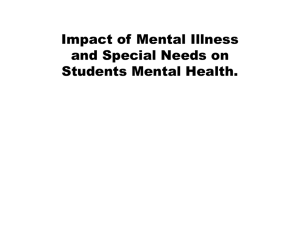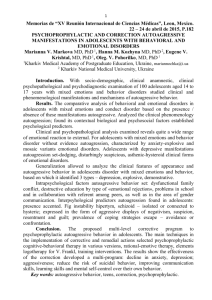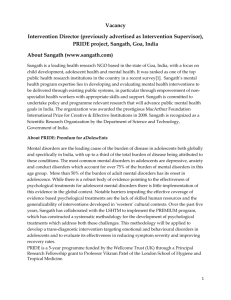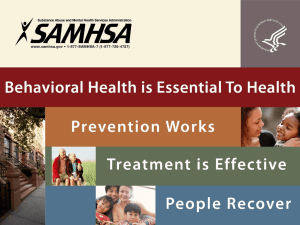Child and Adolescent Mental Health
advertisement
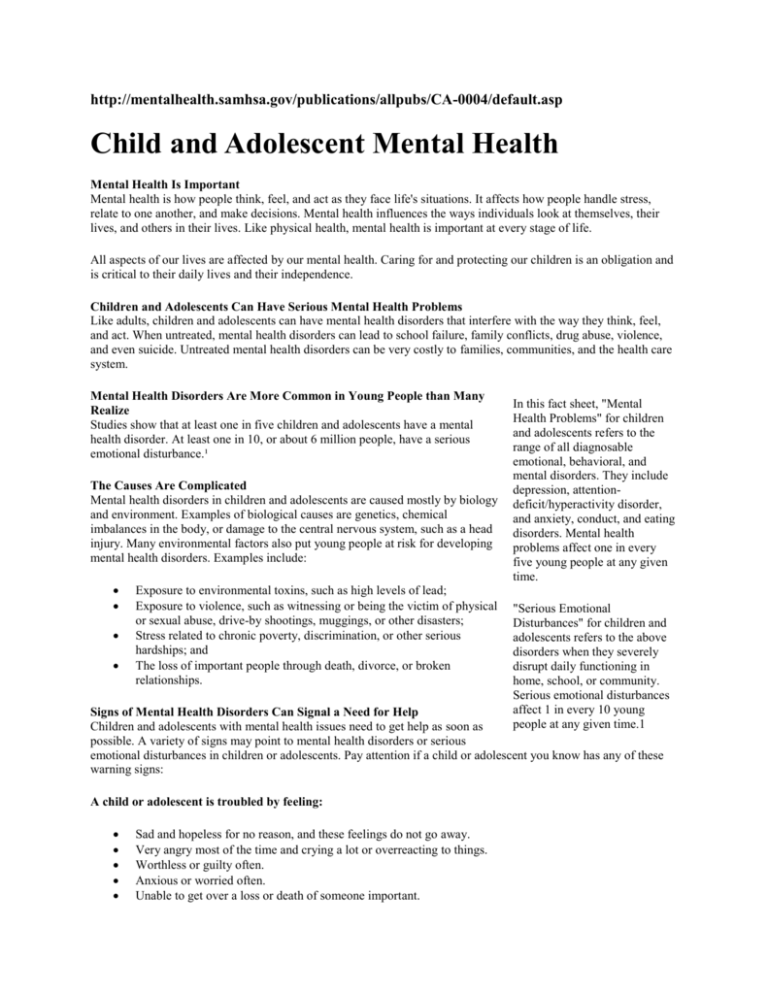
http://mentalhealth.samhsa.gov/publications/allpubs/CA-0004/default.asp Child and Adolescent Mental Health Mental Health Is Important Mental health is how people think, feel, and act as they face life's situations. It affects how people handle stress, relate to one another, and make decisions. Mental health influences the ways individuals look at themselves, their lives, and others in their lives. Like physical health, mental health is important at every stage of life. All aspects of our lives are affected by our mental health. Caring for and protecting our children is an obligation and is critical to their daily lives and their independence. Children and Adolescents Can Have Serious Mental Health Problems Like adults, children and adolescents can have mental health disorders that interfere with the way they think, feel, and act. When untreated, mental health disorders can lead to school failure, family conflicts, drug abuse, violence, and even suicide. Untreated mental health disorders can be very costly to families, communities, and the health care system. Mental Health Disorders Are More Common in Young People than Many Realize Studies show that at least one in five children and adolescents have a mental health disorder. At least one in 10, or about 6 million people, have a serious emotional disturbance.¹ The Causes Are Complicated Mental health disorders in children and adolescents are caused mostly by biology and environment. Examples of biological causes are genetics, chemical imbalances in the body, or damage to the central nervous system, such as a head injury. Many environmental factors also put young people at risk for developing mental health disorders. Examples include: Exposure to environmental toxins, such as high levels of lead; Exposure to violence, such as witnessing or being the victim of physical or sexual abuse, drive-by shootings, muggings, or other disasters; Stress related to chronic poverty, discrimination, or other serious hardships; and The loss of important people through death, divorce, or broken relationships. In this fact sheet, "Mental Health Problems" for children and adolescents refers to the range of all diagnosable emotional, behavioral, and mental disorders. They include depression, attentiondeficit/hyperactivity disorder, and anxiety, conduct, and eating disorders. Mental health problems affect one in every five young people at any given time. "Serious Emotional Disturbances" for children and adolescents refers to the above disorders when they severely disrupt daily functioning in home, school, or community. Serious emotional disturbances affect 1 in every 10 young people at any given time.1 Signs of Mental Health Disorders Can Signal a Need for Help Children and adolescents with mental health issues need to get help as soon as possible. A variety of signs may point to mental health disorders or serious emotional disturbances in children or adolescents. Pay attention if a child or adolescent you know has any of these warning signs: A child or adolescent is troubled by feeling: Sad and hopeless for no reason, and these feelings do not go away. Very angry most of the time and crying a lot or overreacting to things. Worthless or guilty often. Anxious or worried often. Unable to get over a loss or death of someone important. Extremely fearful or having unexplained fears. Constantly concerned about physical problems or physical appearance. Frightened that his or her mind either is controlled or is out of control. A child or adolescent experiences big changes, such as: Showing declining performance in school. Losing interest in things once enjoyed. Experiencing unexplained changes in sleeping or eating patterns. Avoiding friends or family and wanting to be alone all the time. Daydreaming too much and not completing tasks. Feeling life is too hard to handle. Hearing voices that cannot be explained. Experiencing suicidal thoughts. A child or adolescent experiences: Poor concentration and is unable to think straight or make up his or her mind. An inability to sit still or focus attention. Worry about being harmed, hurting others, or doing something "bad". A need to wash, clean things, or perform certain routines hundreds of times a day, in order to avoid an unsubstantiated danger. Racing thoughts that are almost too fast to follow. Persistent nightmares. A child or adolescent behaves in ways that cause problems, such as: Using alcohol or other drugs. Eating large amounts of food and then purging, or abusing laxatives, to avoid weight gain. Dieting and/or exercising obsessively. Violating the rights of others or constantly breaking the law without regard for other people. Setting fires. Doing things that can be life threatening. Killing animals. Comprehensive Services through Systems of Care Can Help Some children diagnosed with severe mental health disorders may be eligible for comprehensive and communitybased services through systems of care. Systems of care help children with serious emotional disturbances and their families cope with the challenges of difficult mental, emotional, or behavioral problems. To learn more about systems of care, call the National Mental Health Information Center at 1-800-789-2647, and request fact sheets on systems of care and serious emotional disturbances, or visit the Center's web site at http://mentalhealth.samhsa.gov Finding the Right Services Is Critical To find the right services for their children, families can do the following: Get accurate information from hotlines, libraries, or other sources. Seek referrals from professionals. Ask questions about treatments and services. Talk to other families in their communities. Find family network organizations. It is critical that people who are not satisfied with the mental health care they receive discuss their concerns with providers, ask for information, and seek help from other sources. Important Messages About Child and Adolescent Mental Health: Every child's mental health is important. Many children have mental health problems. These problems are real, painful, and can be severe. Mental health problems can be recognized and treated. Caring families and communities working together can help. Information is available; call 1-800-789-2647. This is one of many fact sheets on children's mental health disorders. All the fact sheets listed below are written in an easy-to-read style. Families, caretakers, and media professionals may find them helpful when looking for information about mental health disorders. For free copies, call 1-800-789-2647, or visit http://mentalhealth.samhsa.gov Fact Sheets on Related Topics: Order Number CA-0000 CA-0004 CA-0005 CA-0007 CA-0008 CA-0009 CA-0010 CA-0011 CA-0014 Title Caring for Every Child's Mental Health Campaign Products Catalog Child and Adolescent Mental Health Child and Adolescent Mental Health: Glossary of Terms Children and Adolescents With Anxiety Disorders Children and Adolescents With Attention-Deficit/Hyperactivity Disorder Children and Adolescents With Autism Children and Adolescents With Conduct Disorder Children and Adolescents With Severe Depression Facts About Systems of Care for Children's Mental Health Mental Health Resources on the internet: Centers for Disease Control and Prevention www.cdc.gov/mentalhealth/ ClinicalTrials.gov, National Institutes of Health www.clinicaltrials.gov Food and Drug Administration www.fda.gov Substance Abuse and Mental Health Services Administration www.samhsa.gov A Family Guide to Keeping Youth Mentally Healthy and Drug Free www.samhsa.gov/centers/clearinghouse/clearinghouses.html SAMHSA's National Mental Health Information Center http://mentalhealth.samhsa.gov National Institute of Mental Health www.nimh.nih.gov Child and Adolescent Mental Health www.nimh.nih.gov/publicat/pubListing.cfm?dID=23 Endnotes ¹ U.S. Department of Health and Human Services. (1999). Mental Health: A Report of the Surgeon General. Rockville, MD: U.S. Department of Health and Human Services. CA-0004 11/03




